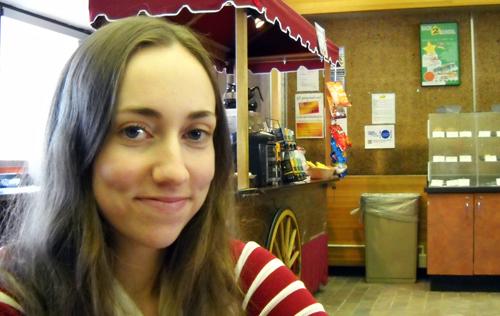
Fat cells might sound like the couch potatoes of the body, but they’re part of an active tissue, says Anna De Boer.
Also called adipocytes, fat cells release hormones. Among their varied functions, those hormones tell you when you’re full or signal your skeletal muscles to burn more energy from fat.
Learning more about how such hormones work – and how they’re involved in obesity and Type 2 diabetes – is the goal for De Boer. A PhD student in the Department of Human Health and Nutritional Sciences (HHNS), she’s working with Prof. Lindsay Robinson.
She’s especially interested in how a particular hormone called adiponectin affects the body’s immune system and how dietary fats such as omega-3s might reduce inflammation associated with obesity.
In effect, her work might help us look at obesity in a new way. “Obesity might soon be considered an autoimmune disease,” says De Boer.
It’s not clear just how adiponectin works, she says.
To learn more, she uses an agent such as a bacterial toxin to stimulate macrophages, or cells that ingest pathogens or debris in the body. Macrophages also prompt responses from other parts of the immune system.
That process causes inflammation as part of the normal immune response. In this case, she says, inflammation is a good thing – unless it’s prolonged. Adiponectin helps to blunt the response, signalling an end to the condition.
“That’s probably good if the macrophage knows when to turn off the inflammation and start clearing out the debris, especially in obese fat tissue where adipocytes are dying or secreting lipid that macrophages need to clean up.”
With obesity, something goes wrong. Far from just involving more weight, she says, “obesity is a chronic inflammatory state.” Fat tissue undergoes expansion and remodelling in obesity. If that process isn’t kept in check by cells like macrophages, inflammation persists.
That state may lead to further problems, including breakdown of the body’s normal insulin mechanism for wiping up blood glucose. And that can make obese people more likely to develop Type 2 diabetes, says De Boer.
She studies how omega-3 fatty acids in our diet, such as DHA and EPA in fish, eggs and fortified milk, work as anti-inflammatory agents. “We want to learn to use these to reduce tissue inflammation and reduce inflammatory cross-talk between adipocytes and macrophages.”
Omega-3s increase adiponectin secretion from fat cells, so that might be one anti-inflammatory mechanism.
For her research, De Boer looks at anti-inflammatory effects of these healthy fats added to cell culture models and fed to live mice.
“Ultimately I’m interested in this emerging field called immuno-metabolism, trying to understand how diet affects the immune system and how this affects physiology or development of disease.”
A number of studies by HHNS researchers have looked at the benefits of omega-3 fatty acids in regulating blood sugar levels and helping to prevent obesity, cardiovascular disease and Type 2 diabetes.
She adds, “We’re helping to validate the role of omega-3s in yet another aspect of health, and that’s your immune system.”
Those connections come home for De Boer, who has various allergies and other autoimmune concerns. She’s interested in “how everyday things like diet are affecting my own conditions – how our diet affects the risk of developing autoimmune diseases or allergies.
She grew up in Guelph and attended Centennial CVI before coming to U of G to study biological science. After an undergrad research project in HHNS, she decided to pursue grad studies. “I’ve always been a person with lots of questions.”
Her U of G connections stem from childhood, when she visited the annual College Royal open house with her parents, both Guelph grads.
Her father, Herman, completed a PhD in animal and poultry science in 1989; her mother, Susan, completed a master’s degree in the same department in 1986.
Eating a varied, balanced diet and staying active to build and maintain muscle mass are part of De Boer’s recipe for staying fit. She cycles, rides horses and belly dances.